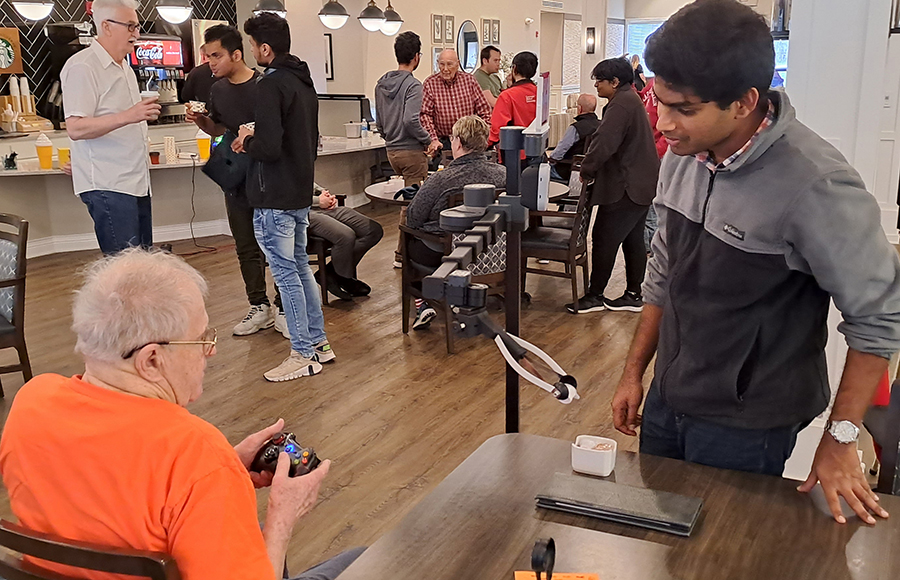CMU Team Explores Future of Caregiving With Assistive Robot
Eric AshtonThursday, July 13, 2023Print this page.

Carnegie Mellon University students recently gave residents of a senior living community a taste of robot-delivered ice cream while demonstrating the potential future of caregiving.
A team of graduate students in the Robotics Institute took a robot named Alfred to Vitalia North Olmsted, a senior living community outside Cleveland. Designed to assist the elderly with daily activities like fetching and delivering objects, Alfred consists of a rolling base not much larger than a robotic vacuum and a long pole-like body with an arm and gripper.
After the residents ate lunch, it was showtime for Alfred. For dessert, the CMU team set up cups of ice cream. Residents approached Alfred, requested a flavor, and watched as the robot navigated to the appropriate cup and handed them the ice cream.
"The residents were overwhelmingly excited about the robot," said Zackory Erickson, an assistant professor in the Robotics Institute and co-advisor of the students working on Alfred.
After delivering dessert, Alfred mingled with the crowd, showing off its social skills by making basic conversation and even cracking a few jokes thanks to the artificial intelligence incorporated into the robot's design. Under the hood, Alfred runs an AI and a large language model called GPT-3.5 — similar to what is deployed in chatbots like ChatGPT — and a synthetic voice generator called Neural2. GPT-3.5 allows Alfred to generate humanlike responses in text, which Neural2 then converts to audio. The result allows Alfred to communicate more fluidly with people.
"Many of the residents had heard about AI but they didn't actually know what it's capable of when it's grounded in a physical system," Erickson said. "The visit and ensuing discussions about AI were definitely insightful for a lot of the residents."
The robot can also show emotion through its facial expressions. A tablet display representing Alfred's face will change the robot's eyes to indicate if Alfred is happy, confused, excited or feeling other emotions depending on the task it's asked to complete. Alfred's tablet/face can also be used to make video calls via voice command. The robot also packs the autonomous skills to navigate hallways on its own and to pick up and deliver household objects.
Alfred impressed Vitalia's staff members, who were excited about the possibility of implementing assistive robots into senior communities. Staff suggested that a robot could free up their time by coordinating phone calls between residents and family members, or knocking on residents' doors to announce meal or event times. Assistive robots could also detect when a resident has fallen and alert the staff to help.

"We are thrilled to be collaborating with Carnegie Mellon," said Mario Sinicariello, president and CEO of Vitalia. "The positive response from our Vitalia North Olmsted residents as they interacted with Alfred shows these technologies can continue to enhance the lifestyle in our communities. We are encouraged by how Alfred can provide valuable support to both our staff and residents."
"The technology aims to add value to the system and empower staff members to spend more time with residents and activities that matter most to them," Erickson added.
Even though Alfred is a work in progress and can't yet perform all the tasks staff and residents suggested, the future looks bright. The robot can be controlled by voice commands or a handheld gaming controller, and many residents volunteered and had fun steering Alfred around, making him pick up objects along the way.
"I was definitely surprised by the gap in the perception of technology," said Shaolin Kataria, a student on the team. "Something that seems so simple or mundane to students because we are exposed to it every day and we understand how it works was perceived with so much excitement by the staff and residents alike."
Residents quickly picked up on how to control Alfred, a nod to the intuitive nature of the design. Ease of use and embracing the technology bodes well for future implementation.
"What thrilled me most was witnessing the culmination of our unwavering commitment in constructing a robot that is now poised for deployment in an actual facility," said Praveen Venkatesh, another student on the team. "It represents the realization of our efforts and signifies the immense potential it holds for making a tangible impact. It's truly exhilarating to witness the convergence of cutting-edge technology and its seamless adaptability for use by elderly citizens."
The visit to Vitalia marked an exciting challenge for Alfred and the student team. Seeing the robot function in the community it was designed for and getting feedback from residents was an important step toward developing technology that could improve the quality of life for residents.
"This type of technology needs to be built with input from the stakeholders — staff members and residents alike," Erickson said.
Alfred was a capstone project for students in the Master of Science in Robotic Systems Development program. In addition to Kataria and Venkatesh, the team also included Abhinav Gupta, Atharva Pusalkar and Shivam Tripathy. They were advised by Erickson and Yonatan Bisk, an assistant professor in the Language Technologies Institute.
The team will spend another semester improving Alfred's design and making more visits to senior living facilities to test the robot's abilities. You can follow their progress on their website.
Aaron Aupperlee | 412-268-9068 | aaupperlee@cmu.edu
